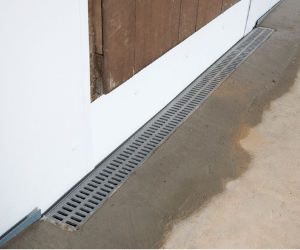French Drain Innovations: Out with the Old, in with the New
A new interior drainage system can overcome the challenges associated with a traditional French drain installed along the outside of the foundation.
A French drain is a common mitigation technique used to reduce the risk of flood damage in homes. For many years, French drains were installed around the exterior of the foundation walls during new construction, but external French drains are known to have several problems. French drain techniques have significantly evolved to overcome weaknesses of the old design.
Basement Systems, Inc., an innovator of basement waterproofing products and a nationwide network of basement waterproofers, explains the pros and cons of French drains and outlines how the design of a new interior drainage system can be beneficial.
Old Solution: Exterior French Drain
A French drain, whether interior or exterior, is a trench filled with either gravel, rock, or a perforated pipe that redirects surface water and groundwater. While it's a common waterproofing solution, an external French drain is prone to clogging due to several factors. When a French drain is installed around a home, it's typically laid in a thick bed of gravel to protect it from mud and soil. In some cases, a layer of filter fabric is also used to help protect the material from this soil. Over several years, mud and sand will end up inside the drain, clogging the pipe. Filter fabric often clogs and keeps water from entering the drain. The external drainage system is typically installed without a sump pump and relies on gravity to drain foundation water. Performing maintenance on an external French drain involves expensive excavation, which usually includes the removal of gardens, stairs, porches, walkways, and other structures along the perimeter of the building.
New Method: Interior French Drain

An interior French drain is installed along the perimeter of the basement underneath the floor. As water flows in through the foundation wall floor joint or cracks in the foundation, it filters through a bed of gravel and into the perimeter drainage pipe. From there, it’s directed to a sump pump and drained beyond the foundation soil. In the unlikely event of a clog, the interior drainage system can easily be serviced without the need for external excavation. Annual maintenance can help ensure the drainage system and sump pump are operating correctly. While exterior drainage systems were once the go-to foundation waterproofing method, an interior drainage system is now a popular solution. A waterproofing system with a transferable warranty ensures that the basement will stay dry in any weather.
Basement Waterproofing
Basement System’s innovative interior French drain system is the best in the industry. The waterproofing contractors in our network are certified and in good standing with their local Better Business Bureau. Basement Systems will set you up with a consultation with your local Basement Systems contractor, who will provide you with a basement waterproofing estimate.
